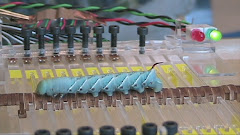It gets pretty confusing about what I do for Ph.D. I am in the Biology Department at Tufts University, getting my Ph.D in biology. However, I've worked with people from biomedical engineering, mechanical engineering, electrical engineering, and computer sciences in the course of my Ph.D training. In fact, most of my colleagues start to think that I'm from "their department" (whatever it is). What exactly am I? That's a very good question which I actually does not have an answer to. Perhaps after I summarize my primary Ph.D research projects below, you may call me whatever you wish with a better understanding of what you are referring to.
My first project at Tufts was to design a force beam array to collect ground reaction forces from all the leg contacts from Manduca caterpillars in two directions simultaneously. This system involves synchronized video tracking and alternative force transducer design. The results suggested that caterpillars may use the substrate to transmit force much like an external skeleton. I'm currently working on the manuscript for the second part of the animal study.
For soft-bodied animals, tissue material properties can contribute greatly to the overall behaviors. My second project at Trimmer Lab was to instrument a lever-arm system to perform uniaxial tests on soft cuticle from the Manduca caterpillar. These soft specimens were often 5mm long and less than 1mm wide. Real-time video extensometry was necessary to control the strain. We then attempted an constitutive model for the material.
To understand how tissue mechanical properties affect the overall animal behaviors, one must go to the structural level. My third project was to investigate the overall structural properties of the Manduca caterpillar over a scaling range. We tracked down all the body tissue that could take mechanical loads and simulate the hydrostatic skeleton in a FEA model. We found a dramatic increase of flexural stiffness associated with body miniaturization. This implies several evolutionary constraint on caterpillar body plans.
Going beyond the Manduca crawling, I wanted to explore some clues about how caterpillars developed inching gaits in the course of evolution. I first simulated different crawling and inching gaits in my first soft-bodied robot lineage. Then I created a second robot lineage to simulate some ballistic behaviors which were supposed to derive from the normal locomotor patterns. Finally, I conducted a field work in Costa Rica to examine all these caterpillar behaviors in nature across different species.
In summary, my practical skills in the lab allowed me to design systems, acquire all the parts/supplies, manufacture/implement devices, and program systems to execute experiments. I would summarize my scientific contribution in my little niche in three statements.
1) During locomotion, soft-bodied animals can use the substrate as their external skeleton, and therefore gain stability and robustness.
2) The mechanical scaling of hydrostatic skeleton may limit the prolegs configurations and locomotor modes in caterpillars.
3) Soft-bodied robots, by definition, cannot rely on exact postural control. The very minute such a robot force a conformation, it becomes rigid.
Subscribe to:
Post Comments (Atom)

.jpg)
No comments:
Post a Comment